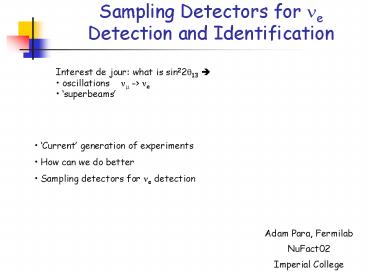Sampling Detectors for ne Detection and Identification - PowerPoint PPT Presentation
Title:
Sampling Detectors for ne Detection and Identification
Description:
Sampling Detectors for ne Detection and Identification. Adam Para, Fermilab. NuFact02 ... Needle in a Haystack ? NC Background. ne (|Ue3|2 = 0.001) ne background ... – PowerPoint PPT presentation
Number of Views:27
Avg rating:3.0/5.0
Title: Sampling Detectors for ne Detection and Identification
1
Sampling Detectors for ne Detection and
Identification
- Interest de jour what is sin22q13 ?
- oscillations nm -gt ne
- superbeams
- Current generation of experiments
- How can we do better
- Sampling detectors for ne detection
- Adam Para, Fermilab
- NuFact02
- Imperial College
2
Different baselines where the oscillation peaks
are ?
L(km)/n 1 2 3
300 0.73 GeV 0.24 GeV 0.15 GeV
750 1.82 GeV 0.60 GeV 0.36 GeV
1500 3.64 GeV 1.21 GeV 0.73 GeV
En lt 1 GeV (KEK/JHF to SuperK, CERN to Frejus
0.3 lt En lt 3 GeV (NuMI)
0.5lt En lt 6 GeV (CERN to Taranto, BNL to ?)
Flux/rates drop
3
Neutrino Cross Sections
Many particles
Nlepton
Nlp
4
What will MINOS do?
Two functionally identical neutrino detectors
Det. 1
Det. 2
5
ne Interactions in MINOS?
- NC interactions
- Energy distributed over large volume
ne CC, Etot 3 GeV
NC, Eobs 3 GeV
- ne CC interactions (low y)
- Electromagnetic shower
- Short
- Narrow
- Most of the energy in a narrow cluster
- Detector Granularity
- Longitudinal 1.5X0
- Transverse RM
energy
6
Needle in a Haystack ? NC Background
n spectrum
NC (visible energy), no rejection
Spectrum mismatch These neutrinos contribute to
background, but no signal
ne (Ue32 0.001)
- ne background
7
MINOS Limits on nm to ne Oscillations
10 kton-yr exposure, Dm20.003 eV2,
Ue320.01 Signal (e 25) - 8.5 ev ne
background - 5.6 ev Other (NC,CC,nt)
34.1 ev M. Diwan,M. Mesier, B. Viren, L. Wai,
NuMI-L-714 90 CL Ue32lt 0.01 Limit
comparable to a far superior detector (ICARUS) in
CNGS beam
Sample of ne candidates defined using
topological cuts
8
Receipe for a Better Experiment
- More neutrinos in a signal region
- Less background
- Better detector (improved efficiency, improved
rejection against background) - Bigger detector
- Lucky coincidences
- distance to Soudan 735 km, Dm20.025-0.035 eV2
- Below the tau threshold! (BR(t-gte)17)
9
Two body decay kinematics
At this angle, 15 mrad, energy of produced
neutrinos is 1.5-2 GeV for all pion energies ?
very intense, narrow band beam
- On axis En0.43Ep
10
Off-axis magic ( D.Beavis at al. BNL Proposal
E-889)
1-3 GeV intense beams with well defined energy in
a cone around the nominal beam direction
11
NC/ ne /p0 detectors
12
CHARM II (nme scattering)
- Challenges
- Identify electrons
- Small cross section, large background from NC
interactions
- Solution
- Low Z, fine grained calorimeter
13
Detector(s) Challenge
- Surface (or light overburden)
- High rate of cosmic ms
- Cosmic-induced neutrons
- But
- Duty cycle 0.5x10-5
- Known direction
- Observed energy gt 1 GeV
- Principal focus electron neutrinos
identification - Good sampling (in terms of radiation/Moliere
length) - Large mass
- maximize mass/radiation length
- cheap
14
A possible detector an example
Cheap low z absorber recycled plastic
pellets Cheapest detector glass RPC (?)
15
Constructing the detector wall
- Containment issue need very large detector
- Engineering/assembly/practical issues
16
On the Importance of the Energy Resolution
Cut around the expected signal region too improve
signal/background ratio
- M. Messier, Harvard U.
17
Energy resolution vis-à-vis oscillation pattern
- First oscillation minimum energy resolution/beam
spectrum 20 well matched to the width of the
structure - Second maximum 20 beam width broader than the
oscillation minimum, need energy resolution lt10.
Tails??
18
Energy Resolution of Digital Sampling Calorimeter
- Digital sampling calorimeter
- 1/3 X0 longitudinal
- 3 cm transverse
- Energy Cx( of hits)
- DE 15 _at_ 2 GeV
- DE 10 4-10 GeV
- 15 non-linearity _at_ 8 GeV, no significant
non-gaussian tails
19
Improve energy resolution?
- Total Absorption Calorimeter HPWF
Energy resolution limited by fluctuations of the
undetected energy nuclear binding energy,
neutrinos and not by sampling fluctuations Crude
sampling calorimeter (CITFR), 10 cm steel,
better energy resolution than total absorption
one (HPWF)
20
Neutrino energy, Quasi-elastics ?
m
nm n ? m p
(Em , pm)
n
p
m events
En(reconstruct)
s80MeV
En(reconstruct) En (True) (MeV)
21
2 GeV CC ne / NC interactions
22
2 GeV nm CC interaction
23
7 GeV CC ne / NC interactions
24
CC ne vs NC events example
- Electron candidate
- Long track
- showering I.e. multiple hits in a road around
the track - Large fraction of the event energy
- Small angle w.r.t. beam
- NC background sample reduced to 0.3 of the final
electron neutrino sample (for 100 oscillation
probability) - 35 efficiency for detection/identification of
electron neutrinos
25
Detector questions/issues
- What is the optimal absorber material (mostly an
engineering/cost question, if DX0 kept constant) - What longitudinal sampling (DX0)?
- What is the desired density of the detector?
(containment/engineering/transverse segmentation) - Containment issues fiducial volume vs total
volume, engineering issues what is the practical
detector size? - What is the detector technology (engineering/cost
issue if transverse segmentation kept constant) - What is the optimal transverse segmentation
(e/p0, saturation,) - Can a detector cope with cosmic ray background?
What is the necessary timing resolution?































